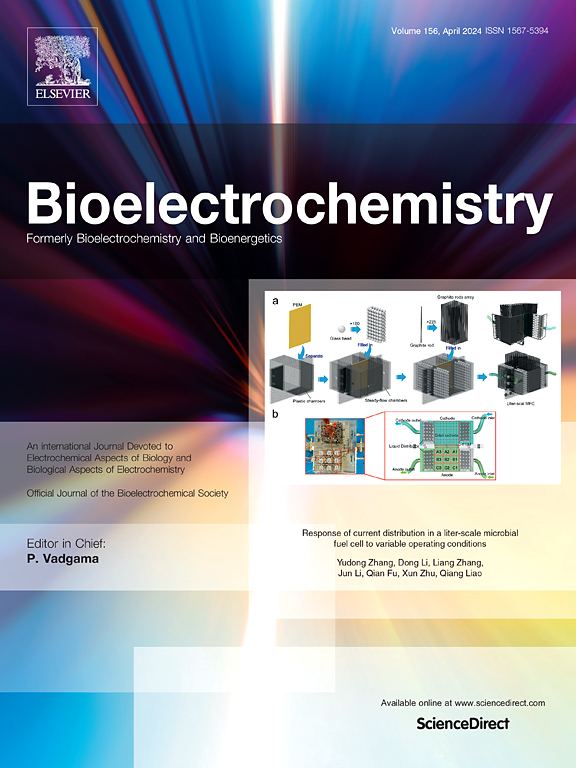集成 MoS2/CuS-Au 和 SI-RAFT 的增强型电化学传感器,用于 cTnI 检测中的双重信号放大。
IF 4.8
2区 化学
Q1 BIOCHEMISTRY & MOLECULAR BIOLOGY
引用次数: 0
摘要
众所周知,心肌肌钙蛋白 I(cTnI)是急性心肌梗死(AMI)的主要诊断生物标志物之一。本文提出了一种以纳米材料 MoS2/CuS-Au 为基底材料,以紫苏醛(PA)为表面引发的可逆加成片段链转移(SI-RAFT)聚合单体,通过在电极表面原位沉积银金属来超灵敏检测 cTnI 的电化学传感器。基底材料 MoS2/CuS-Au 不仅加快了电子间的转移速度,还为适配体的引入提供了更多的活性位点。通过表面引发的可逆加成片段链转移聚合(SI-RAFT)将过醛(PA)单体修饰到电极上,并将银离子还原成金属银沉积在电极表面上部,从而一步放大了信号。在最佳反应条件下,该传感器的检测限低至 10.83 fg-mL-1。这种拟合传感器不需要额外的天然酶或生物标签,有望用于早期急性心肌梗死(AMI)的诊断。本文章由计算机程序翻译,如有差异,请以英文原文为准。
Enhanced electrochemical aptasensor integrating MoS2/CuS-Au and SI-RAFT for dual signal amplification in cTnI detection
Cardiac troponin I (cTnI) is known to be among the prominent diagnostic bio-marker for acute myocardial infarction (AMI). In this paper, we proposed an electrochemical aptasensor with nanomaterial MoS2/CuS-Au as the substrate material and perillaldehyde (PA) as the surface-initiated reversible addition fragmentation chain transfer (SI-RAFT) polymerization monomer by mediating the in-situ deposition of silver metal on the electrode surface for ultrasensitive detection of cTnI. The substrate material MoS2/CuS-Au not only accelerated the rate transfer between electron, but also provided more active sites for aptamers introduction. The perillaldehyde (PA) monomers were modified onto the electrode by surface-initiated reversible addition fragmentation chain transfer polymerization (SI-RAFT), and the signal was amplified in one step by reducing silver ions to metallic silver deposited in situ on the upper of the electrode surface. Under optimum reaction conditions, this aptasensor achieved a detection limit down to 10.83 fg·mL−1. The proposed aptasensor without additional natural enzymes or biological tags, had a promising potential for use in the diagnosis of early acute myocardial infarction (AMI).
求助全文
通过发布文献求助,成功后即可免费获取论文全文。
去求助
来源期刊

Bioelectrochemistry
生物-电化学
CiteScore
9.10
自引率
6.00%
发文量
238
审稿时长
38 days
期刊介绍:
An International Journal Devoted to Electrochemical Aspects of Biology and Biological Aspects of Electrochemistry
Bioelectrochemistry is an international journal devoted to electrochemical principles in biology and biological aspects of electrochemistry. It publishes experimental and theoretical papers dealing with the electrochemical aspects of:
• Electrified interfaces (electric double layers, adsorption, electron transfer, protein electrochemistry, basic principles of biosensors, biosensor interfaces and bio-nanosensor design and construction.
• Electric and magnetic field effects (field-dependent processes, field interactions with molecules, intramolecular field effects, sensory systems for electric and magnetic fields, molecular and cellular mechanisms)
• Bioenergetics and signal transduction (energy conversion, photosynthetic and visual membranes)
• Biomembranes and model membranes (thermodynamics and mechanics, membrane transport, electroporation, fusion and insertion)
• Electrochemical applications in medicine and biotechnology (drug delivery and gene transfer to cells and tissues, iontophoresis, skin electroporation, injury and repair).
• Organization and use of arrays in-vitro and in-vivo, including as part of feedback control.
• Electrochemical interrogation of biofilms as generated by microorganisms and tissue reaction associated with medical implants.
 求助内容:
求助内容: 应助结果提醒方式:
应助结果提醒方式:


